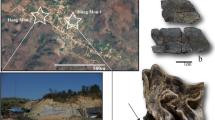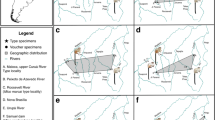Abstract
Recently found materials indicate that the steppe mammoth, Mammuthus trogontherii, survived in northern China into the late Pleistocene. East Asia is the key area of mammoth evolution after the initial radiation of early forms out of Africa and into Eurasia at the beginning of the late Pliocene (c. 3.5-3.0 Ma). M. rumanus, M. meridionalis, M. trogontherii, and M. primigenius probably formed a continuous and transitional evolutionary lineage within the pan-Eurasian mammoth radiation in East Asia. Each speciation event of the Eurasian mammoths was followed by a rapid and large-scale dispersal event: out of East Asia. Allopatric speciation is the main speciation pattern of Mammuthus. The climatic vacillation was severe and frequent in East Asia from the early part of early Pleistocene (c. 2.6 Ma) onward, which probably brought about successive speciation in East Asia and the subsequent dispersal of the mammoths.
Similar content being viewed by others
References
Zhao J X, Yu K F. Timing of Holocene sea-level highstands by mass spectrometric U-series ages of a coral reef from Leizhou Peninsula, South China Sea. Chin Sci Bull, 2002, 47: 1734–1738
Yu K F, Zhao J X, Shi Q, et al. U-series dating of dead Porites corals in the South China Sea: Evidence for episodic coral mortality over the past two centuries. Quat Geochronol, 2006, 1: 129–141
Maglio V J. Origin and evolution of the Elephantidae. Trans Amer Phil Soc, 1973, 63: 1–149
Lister A M, Sher A V, van Essen H, et al. The pattern and process of mammoth evolution in Eurasia. Quat Int, 2005, 126-128: 49–64
Dubrovo I A. A history of elephants of the Archidiskodon-Mammuthus phylogenetic line on the territory of the USSR. J Palaeont Soc India, 1977, 20: 33–40
Van Essen H. Tooth morphology of Mammuthus meridionalis from the south bight of the North Sea and from several localities in the Netherlands. Deinsea, 2003, 9: 453–511
Wei G B, Taruno H, Kawamura Y, et al. Pliocene and Early Pleistocene Primitive Mammoths of Northern China: Their revised taxonomy, biostratigraphy and evolution. J Geosci Osaka City Univ, 2006, 49: 59–101
Lister A M, Sher A V. The origin and evolution of the woolly mammoth. Science, 2001, 294: 1094–1097
Li X G, Liu G L, Xu G Y, et al. The Chinese Mammuthus-Coelodonta fauna and Guxiangtun Formation. In: Proceedings of the First All-Chinese Conference on 14C (in Chinese). Beijing: Science Press, 1984. 121–127
Zhou M Z, Zhang Y P. Pleistocene Mammalian Fossils from the Northeastern Provinces (in Chinese). Beijing: Science Press, 1959. 22–34
Zhou M Z, Zhang Y P. Chinese Proboscidean Fossils (in Chinese). Beijing: Science Press, 1974
Zhen S N, Yang D S, Wei Z Y, et al. A discovery of complete skeleton of Mammuthus sungari from Zhaoyuan, Heilungjiang Province, China (in Chinese). Memories of Beijing Natural History Museum, 1979, 3: 1–9
Cheng D H, Wang Z Y, Wei Z Y. The newly unearthed mammoth specimens from Zalainuoer (in Chinese). Vertebrata PalAsiat, 1982, 20: 88–89
Takahashi K, Wei G B, Uno H, et al. AMS 14C chronology of the world’s southernmost woolly mammoth (Mammuthus primigenius Blum.). Quat Sci Rev, 2007, 126: 954–957
Lister A M, Bahn P. Mammoths. London: Frances Lincoln Ltd, 2007
Wei G B. Taxonomy and biostratigraphy of the Middle Pliocene-Early Pleistocene Mammuthus of northern China, with discussion on the evolution of Eurasian mammoths. Dissertation for the Doctoral Degree. Osaka: Osaka City University, 2004
Lister A M, van Essen H. Mammuthus rumanus (Stefanescu), the earliest mammoth in Europe. In: Petulescu A, Stiuca E, eds. Advances in Vertebrate Paleontology ‘Hen to Panta’. Bucharest: Romanian Academy Institute of Speleology, 2003. 47–52
Titov V V. Most ancient elephants from the south of Russia. In: Cavarretta G, Gioia P, Mussi M, et al, eds. The World of Elephants. Proceeding of the First International Congress, Rome, 2001. 152–156
Palombo M R, Ferretti M P. Elephant fossil record from Italy: Knowledge, problems and perspectives. Quat Int, 2004, 126-128: 107–136
Wang H. An Early Pleistocene mammalian fauna from Dali, Shaanxi (in Chinese with English Summary). Vertebrata PalAsiat, 1988, 26: 59–72
Deng T, Xue X X. Chinese Fossil Horses of Equus and Their Environment (in Chinese with English Summary). Beijing: China Ocean Press, 1999. 1–153
Wei G B, Taruno H, Jin C Z, et al. The earliest specimens of the steppe mammoth, Mammuthus trogontherii from the Early Pleistocene Nihewan Formation, North China. Earth Sci, 2003, 57: 289–298
Wei G B, Lister A M. Significance of the dating of the Majuangou site for understanding Eurasian mammoth evolution (in Chinese with English Summary). Vertebrata PalAsiat, 2005, 43: 243–244
Takahashi K, Namatsu K. Origin of the Japanese Proboscidea in the Plio-Pleistocene. Earth Sci, 2000, 54: 257–267
Stuart A J, Kosintsev P A, Higham T F G, et al. Pleistocene to Holocene extinction dynamics in giant deer and woolly mammoth. Nature, 2004, 431: 684–689
Wiley E O. Phylogenetics: The Theory and Practice of Phylogenetic Systematics. New York: John Wiley and Sons, Inc., 1981. 1–439
Schneider C J. Natural selection and speciation. In: Proc Nat Acad Sci USA, 2000, 97: 12398–12399
Wang P X, Zhao Q H, Jian Z M, et al. Thirty million year deep-sea records in the South China Sea. Chin Sci Bull, 2003, 48: 2524–2535
Guo Z T, Ruddiman W F, Hao Q Z, et al. Onset of Asian desertification by 22 Myr ago inferred from loess deposits in China. Nature, 2002, 416: 159–163
Ruddiman W F, Raymo M E, Martinson B M, et al. Pleistocene evolution: Northern Hemisphere ice sheets and North Atlantic Ocean. Paleoceanography, 1989, 4: 353–412
Author information
Authors and Affiliations
Corresponding author
Rights and permissions
About this article
Cite this article
Wei, G., Hu, S., Yu, K. et al. New materials of the steppe mammoth, Mammuthus trogontherii, with discussion on the origin and evolutionary patterns of mammoths. Sci. China Earth Sci. 53, 956–963 (2010). https://doi.org/10.1007/s11430-010-4001-4
Received:
Accepted:
Published:
Issue Date:
DOI: https://doi.org/10.1007/s11430-010-4001-4




